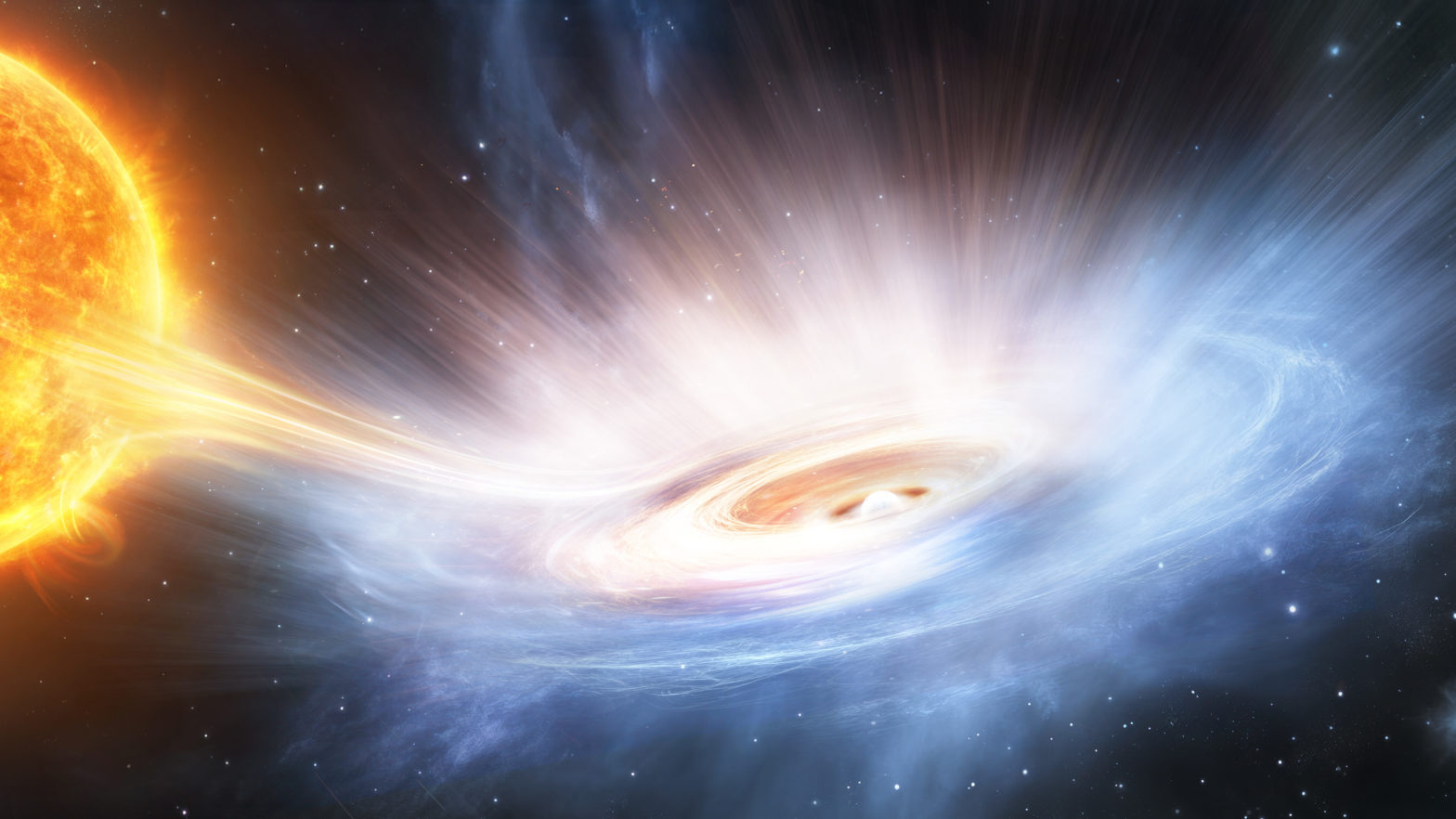The origin of high-energy cosmic rays that travel through space and reach Earth is one of the greatest unsolved mysteries in astrophysics. Recently, black hole X-ray binaries, consisting of a black hole several times the mass of the Sun and a companion star, have emerged as potential sources of cosmic rays. Some X-ray binaries eject fast-moving gas jets, which are believed to act as natural particle accelerators to create high-energy particles that streak across the Galaxy as cosmic rays.
V4641 Sgr is one such system, distinguished by its exceptional particle acceleration capabilities. V4641 Sgr was observed using the X-ray Imaging and Spectroscopy Mission (XRISM)(※1), which is a JAXA-led international project that was launched in September 2023 to perform high-resolution observations of the X-ray radiation that is emitted from some of the most energetic environments in the Universe. By fully utilizing the wide field-of-view and low-background performance (low levels of detector noise) of XRISM’s Xtend CCD camera, the faint extended X-ray emission around the black hole was successfully detected for the first time. This X-ray emission is thought to be from the particles accelerated by the black hole binary, marking only the second detection of X-ray emission associated with particle acceleration near a black hole X-ray binary, following the detection from SS433/W50 (the Manatee Nebula).
Unlike SS433, V4641 Sgr remains remarkably quiet, except for rare outbursts occurring once every few years. Despite its extreme time variability, an analysis of past observation data, inspired by XRISM’s findings, revealed a similar level of extended X-ray emission around V4641 Sgr 22 years ago, during a time when there was no major outburst. This surprising discovery suggests that particle acceleration primarily occurs during its quiescent phases, challenging conventional expectations.
These results provide a significant step forward in understanding particle acceleration processes around black holes and offer new insights into the mechanisms behind Galactic cosmic ray production, driving progress in both observational and theoretical astrophysics.
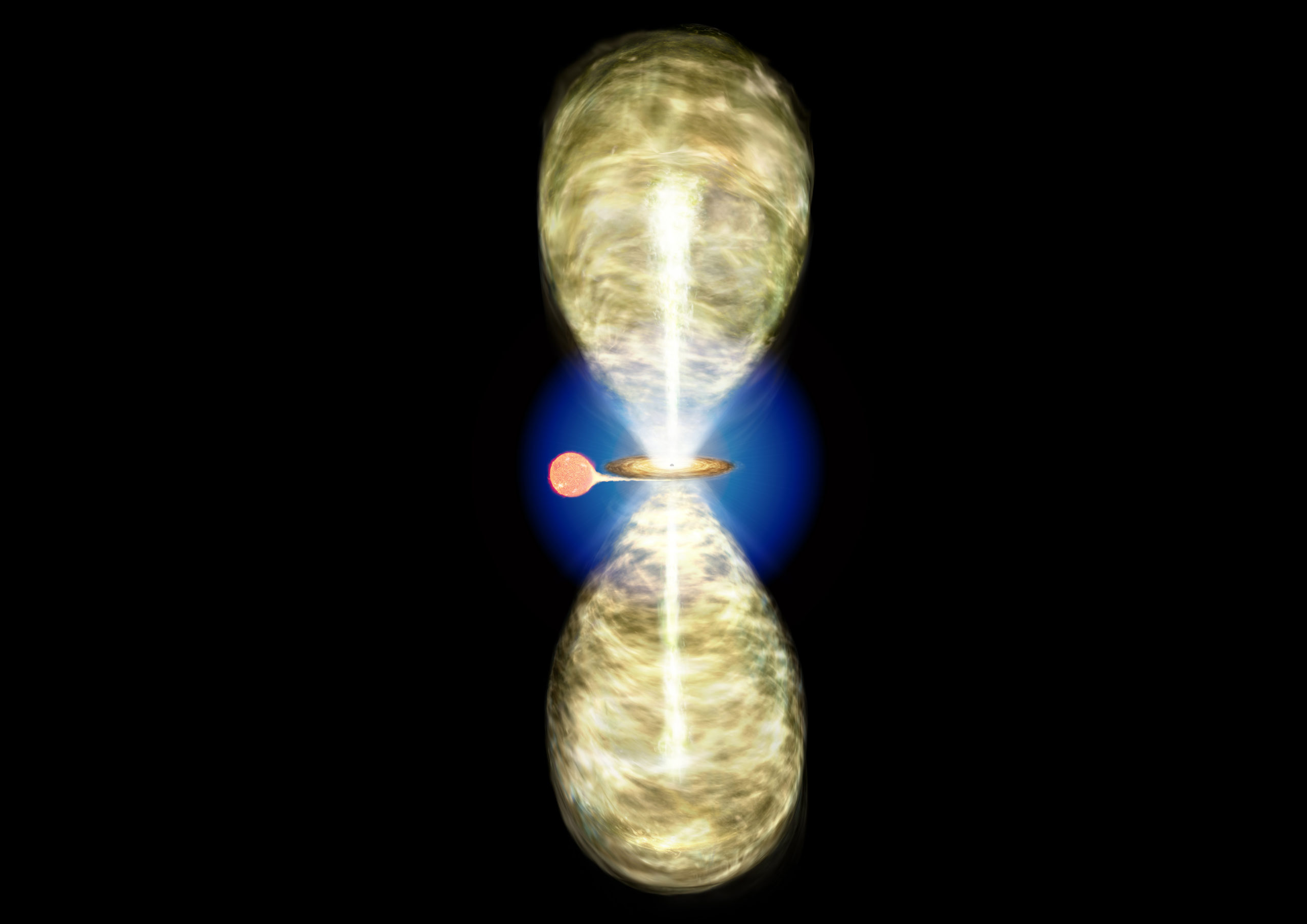
Background of the Study
A black hole X-ray binary is formed when a massive star that is part of an orbiting pair of stars reaches the end of its life and becomes a black hole. Material from the surviving second star in the binary is drawn towards the black hole to form a rapidly rotating ring known as an accretion disc. Some of these systems, such as the well-known SS433/W50 (the Manatee Nebula), eject high-speed jets, which are believed to act as natural particle accelerators that generate cosmic rays. V4641 Sgr is one such black hole X-ray binary (Figure 1), distinguished by its exceptional particle acceleration capabilities, as revealed by recent gamma-ray observations. However, the X-ray data necessary for understanding the physical environment of the particle acceleration had been lacking.
Research Results
V4641 Sgr was observed using the X-ray Imaging and Spectroscopy Mission (XRISM). The observation was conducted under a special program called the Director’s Discretionary Time (DDT), typically reserved for rare phenomena such as nearby supernova explosions. In this case, DDT observation was granted when V4641 Sgr entered a rare X-ray burst phase in September 2024 (Figure 2), an event that occurs approximately once every few years.
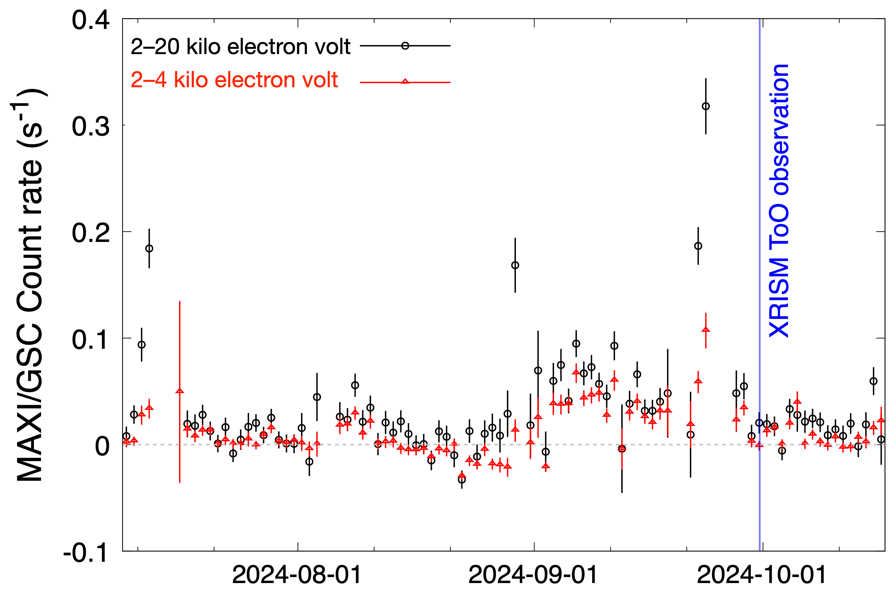
While the primary goal was to conduct precise spectroscopy near the black hole using the XRISM’s Resolve spectrometer instrument, the wide-field X-ray CCD camera Xtend onboard XRISM also yielded significant findings, which were recently published in the Astrophysical Journal Letters, an international journal for astrophysical discoveries. Xtend can image objects over a wide field of view, with low levels of detector noise. By leveraging these capabilities, the faint, extended X-ray emission around the black hole was successfully detected for the first time (Figure 3). Previous X-ray observations by astronomy satellites faced difficulties in distinguishing between faint extended emission and background due to their limited field of view. Thus, the detection of extended emission was nearly impossible prior to XRISM.
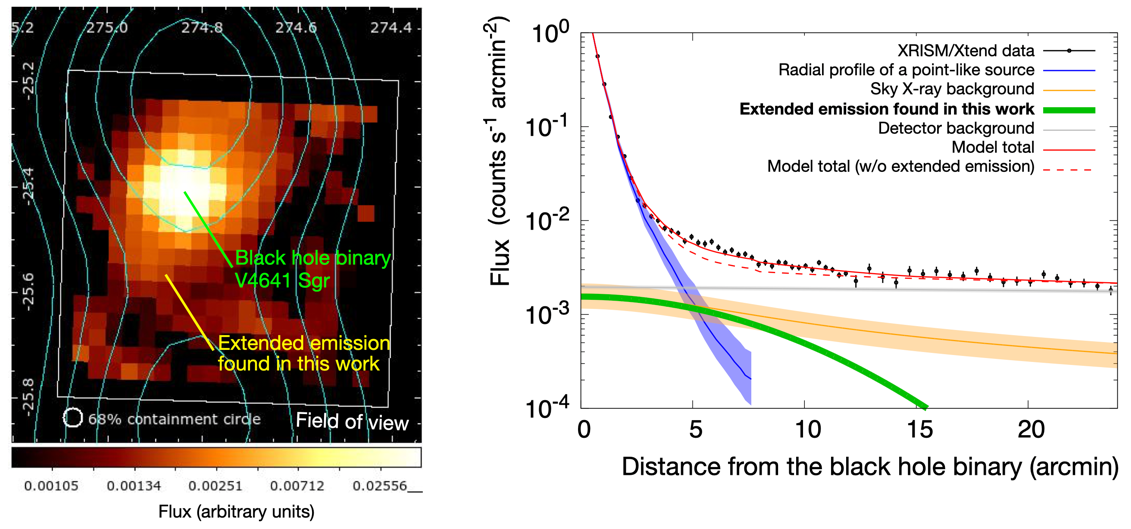
The detected X-ray emission was more concentrated around the black hole than the distribution of high-energy particles inferred from gamma-ray observations, clearly indicating that the particle accelerator mechanism is located very close to the black hole (Figure 4). In addition, the background emission in the direction of V4641 Sgr that was measured with XRISM was applied to archival data from the NASA Chandra X-ray Observatory taken 22 years ago, during periods when the black hole binary was not emitting large burst of X-ray emission. By removing the accurately measured background emission measured by XRISM from the Chandra data, surprising evidence was found of extended emission with a similar brightness in the past data, suggesting that particle acceleration may predominantly occur during quiescent periods, contrary to conventional expectations.
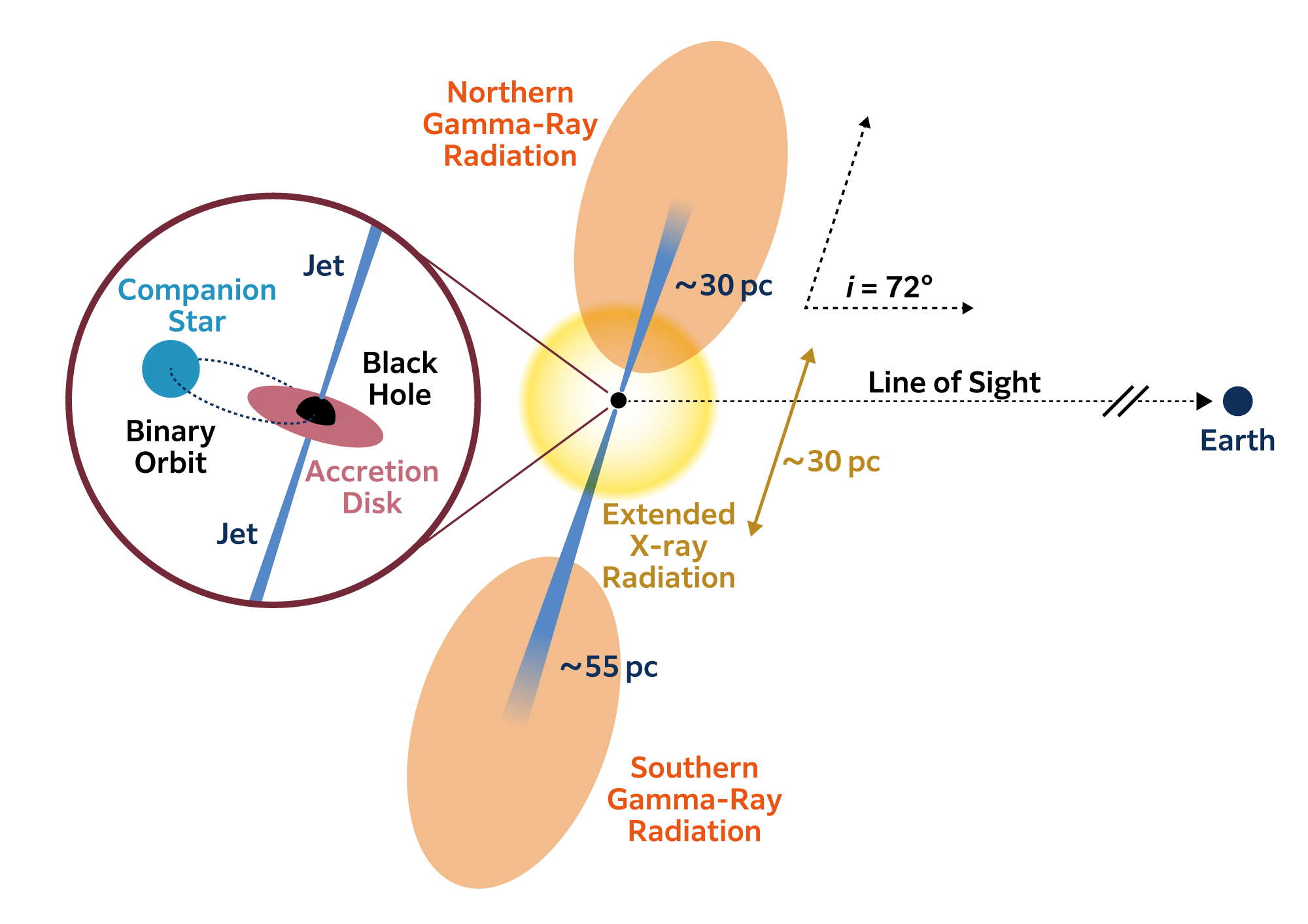
Scientific Significance and Future Prospects
If the suggested particle acceleration during the quiescent phase–where no jet has been observed–is indeed occurring, it implies that particle acceleration is not limited to highly active black holes with observable jets but may be a more general phenomenon. This work will not only stimulate further observational and theoretical studies on V4641 Sgr but also serve as a catalyst for advancing our understanding of particle acceleration in black hole systems and, more broadly, cosmic-ray production across the entire Galaxy. This study marks the first scientific achievement primarily utilizing Xtend, demonstrating its strengths as a standalone instrument, whereas it has often been used as a supplementary tool for Resolve. A second key aspect is that high-sensitivity observations have the potential to expand the limited data on particle accelerators near black holes, providing valuable insights into their nature.
Paper Information
Paper Title: Detection of extended X-ray emission around the PeVatron microquasar V4641 Sgr with XRISM
Authors: Hiromasa Suzuki, Naomi Tsuji, Yoshiaki Kanemaru, Megumi Shidatsu, Laura Olivera-Nieto, Samar Safi-Harb, Shigeo S. Kimura, Eduardo de la Fuente, Sabrina Casanova, Kaya Mori, Xiaojie Wang, Sei Kato, Dai Tateishi, Hideki Uchiyama, Takaaki Tanaka, Hiroyuki Uchida, Shun Inoue, Dezhi Huang, Marianne Lemoine-Goumard, Daiki Miura, Shoji Ogawa, Shogo B. Kobayashi, Chris Done, Maxime Parra, Maria Díaz Trigo, Teo Muñoz-Darias, Montserrat Armas Padilla, Ryota Tomaru, and Yoshihiro Ueda
Journal: The Astrophysical Journal Letters
Publish date: 2025 January 3
DOI: 10.3847/2041-8213/ad9d11




